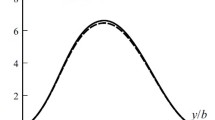Summary
In a plate-theoretical formulation of the shear center problem, the relevant boundary-value problem is for a cantilevered rectangular plate of variable thickness with two free opposite edges and with the edge opposite to the clamped end subject to a rigid vertical displacement and free of bending moment. For plates with Poisson's ratiov equal to zero, there is an exact elementary solution for this boundary-value problem from which the exact location of the shear center can be calculated. When Poisson's ratio is not zero, an approximate elementary solution may be obtained within the framework of a Saint-Venant flexure solution for plates by satisfying the displacement boundary conditions at the clamped edge approximately. Different forms of this approximation are discussed in [7], some with rather marked Poisson's ratio effects. Among these, the minimum complementary energy approach of [6] gives a shear center location identical to the exact solution forv=O.
A generalized beam theory developed in [6] is implemented here to delineate the effect ofv without altering the edge conditions by ad hoc approximations. The results show that the Poisson's ratio effect is rather moderate and the shear center location is nearly the same as that for zero Poisson's ratio. A finite element solution for the plate theory boundary-value problem confirms this finding.
The generalized beam equations are also used to study the effect of the aspect ratio of the plate and orthotropy on the location of the shear center.
Übersicht
In der plattentheoretischen Formulierung des Schubmittelpunktproblems [6] betrifft die relevante Randwertaufgabe eine rechteckige Kragplatte mit veränderlicher Dicke in Querrichtung, mit einer Lastverteilung, welche eine gleichförmige Durchbiegung am belasteten Rand erzeugt.
Die vorliegende Arbeit implementiert eine Näherungslösung dieses Problems in der Form einer verallgemeinerten Balkentheorie zwölfter Ordnung, welche Verwölbung sowie auch anticlastische Krümmung berücksichtigt [6]. Das Ziel ist, den quantitativen Einfluß der Poissonschen Zahl und auch den der Orthotropie zu bestimmen.
Die Resultate zeigen, daß der Einfluß der Poissonschen Zahl, welcher in der bekannten näherungsweisen Bestimmung mit Hilfe des Variationsprinzips für Spannungen vollkommen verschwindet, in der Tat sehr gering ist, insbesondere im Vergleich mit den Folgen einer Anwendung der St.-Venantschen Biegetheorire zusammen mit einer klassischen Stipulierung bezüglich des Verschiebungsfeldes am Schwerpunkt der Querschnittsfläche. Darüber hinausgehend wird gezeigt, daß die numerischen Werte nur unwesentlich von Unterschieden zwischen Isotropie und Orthotropie beeinflußt sind.
Die obigen Resultate werden durch die Ableitung und Anwendung einer Balkentheorie sechzehnter Ordnung und durch Rechnungen mit Hilfe von Finiten Elementen bestätigt.
Similar content being viewed by others
References
Asher, U.; Christiansen, J.; Russell, R. D.: A collocation solver for mixed order systems of boundary value problems. Math. Comp. 33 (1979) 659–679
Duncan, W. T.: The flexural center or centre of shear. J. Roy. Aeron. Soc. 57 (1953) 594–597
Elias, Z. M.: Program PLATE, VAX and PC/AT versions, Civil Engineering Univ. of Washington, Seattle January, 1991
Goodier, J. N.: A theorem on the shearing stress in beams. J. Aeron. Sci. 11 (1944) 272–280
Griffith, A. A.; Taylor, G. I.: The problem of flexure. Reports and Memoranda Adv. Comm. Aeronautics 399 (9117) 1–21
Reissner, E.: The center of shear as a problem of the theory of plates of variable thickness. Ing. Arch. 59 (1989) 325–332
Reissner, E.: Approximate determinations of the center of shear by use of the St.-Venant solution for the flexure problem of plates of variable thickness. Arch. Appl. Mech. 61 (1991) 555–566
Stevensen, A. C.: Flexure with shear and associated torsion. Phil. Trans. Roy. Soc. London/A 237 (1939) 161–229 and 566
Author information
Authors and Affiliations
Rights and permissions
About this article
Cite this article
Gu, C., Wan, F.Y.M. Approximate solutions for the shear center of plates of variable thickness. Arch. Appl. Mech. 63, 513–521 (1993). https://doi.org/10.1007/BF00804753
Received:
Issue Date:
DOI: https://doi.org/10.1007/BF00804753




